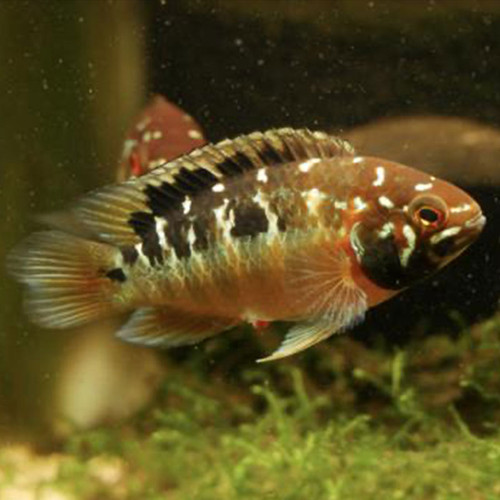Our Guide To Keeping Ivanacara bimaculata Pair Cichlid
-
About Fish Species:
- Scientific name: Ivanacara bimaculata
- Common name: No widely established common name (sometimes called Two-spot Acara or by its scientific name)
- Family: Cichlidae
- Origin: Guyana – Potaro and Essequibo river systems
- Adult length: 5–7 cm
- Lifespan: 3 to 5 years
- Diet: Omnivore (leans toward carnivorous)
- Care Level: Moderate
- Temperament: Peaceful to mildly territorial (especially when breeding)
-
Tank Setup:
- Ivanacara bimaculata thrive in well-structured tanks with hiding places such as caves, driftwood, and leaf litter. A soft sandy substrate is recommended.
- A minimum tank size of 60L is suitable for a bonded pair. For community setups, 100L+ is ideal with careful selection of tank mates.
- Dim lighting and blackwater-style aquascapes closely mimic their natural habitat.
-
Water Parameters:
- Soft, acidic water is best, with a pH of 4.5 to 6.5.
- Temperature should be maintained between 24 to 28°C (75 to 82°F).
-
Filtration and Water Flow:
- Use a gentle to moderate flow with strong biological filtration. Blackwater tannins from Indian almond leaves or driftwood help simulate natural conditions.
- Ensure high water quality through regular, small water changes.
-
Diet:
- Provide a staple of quality micro pellets or small granules formulated for carnivores.
- Supplement frequently with live or frozen foods such as bloodworms, daphnia, brine shrimp, or blackworms to maintain health and breeding condition.
-
Tank mates:
- Best kept as a pair in a species-only tank if breeding.
- In peaceful community tanks, suitable companions include small tetras, pencilfish, hatchetfish, and Corydoras. Avoid larger or aggressive cichlids.
-
Behavior and Compatibility:
- Generally peaceful but can become territorial during spawning.
- They are shy without cover and do best in tanks with visual barriers and minimal disturbance.
- Display fascinating breeding behaviour and strong pair bonds when well cared for.







